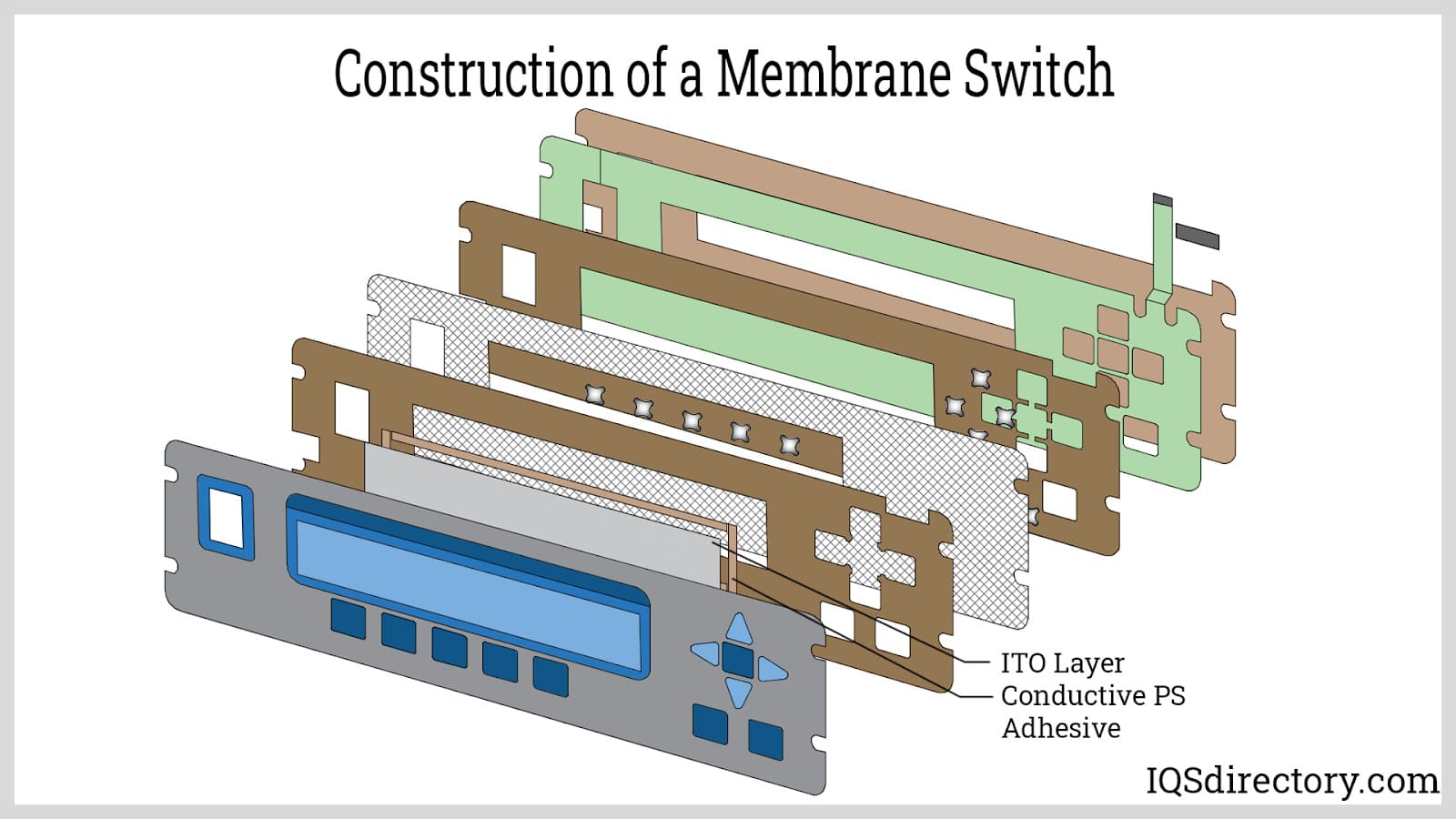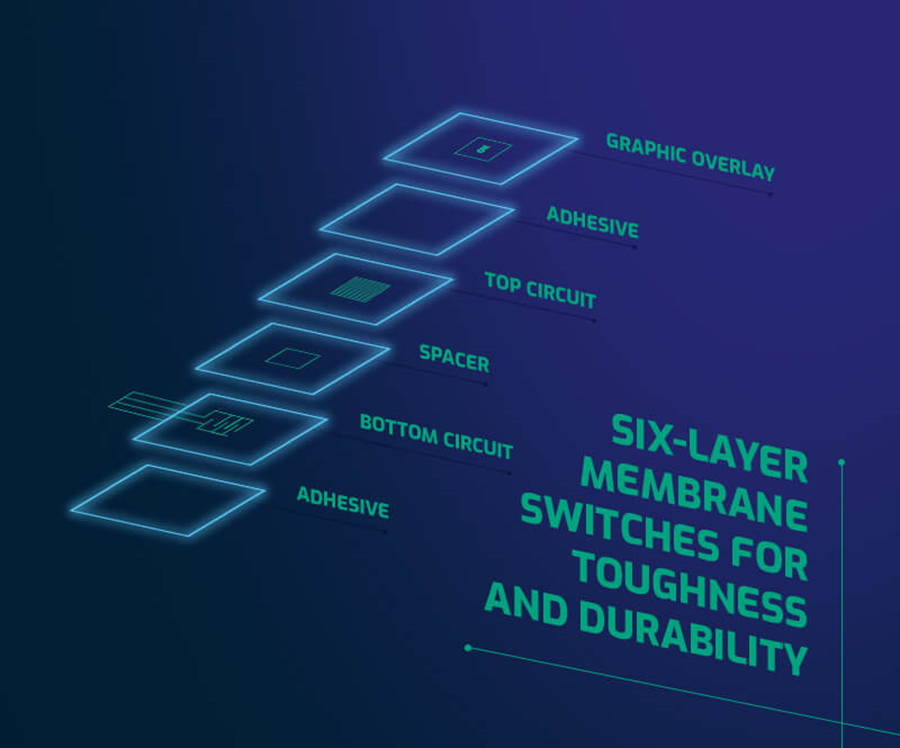Top considerations when choosing a membrane switch for aerospace use
Understanding the Significance of Membrane Switch Over in Modern Electronics
Membrane buttons are integral parts in contemporary electronic gadgets. They offer a mix of performance and design that improves user communication. Their lightweight and durable nature makes them ideal for different applications. As sectors progress, the demand for personalization and advanced functions grows. Recognizing how membrane layer switches add to development discloses their importance in forming the future of electronics. What exists in advance for this technology?
The Essentials of Membrane Layer Switch Over Innovation
Although typically neglected, membrane switch innovation plays a crucial role in the modern electronic devices landscape - membrane switch. These devices, made up of several layers, serve as interface for numerous digital items, varying from family devices to clinical tools. A common membrane layer button contains a visuals overlay, a spacer layer, and a circuit layer, which are meticulously put together to produce a functional interface.When pressure is put on the overlay, the circuit layer is finished, enabling signals to be transferred to the device. This technology is recognized for its convenience, enabling modification in capability, form, and layout to satisfy details user needs. In addition, membrane layer buttons are lightweight and slim, making them appropriate for applications where space is a costs. Their sturdiness and resistance to environmental factors better improve their appeal, ensuring they can withstand rough problems while preserving performance. Generally, membrane switch modern technology is essential to developing user-friendly and effective digital devices

Key Benefits of Membrane Changes
Membrane layer changes deal numerous key benefits that make them a preferred option in different electronic applications. Their style permits for a portable form aspect, making it possible for suppliers to produce lightweight and streamlined devices. In addition, membrane layer switches are resistant to dust, wetness, and chemicals, which boosts their toughness and long life sought after environments. The responsive comments supplied by these buttons can enhance user experience, making them intuitive and easy to operate.Furthermore, membrane switches can be personalized with diverse graphics and colors, enabling special branding chances. The manufacturing process is normally economical, particularly for high-volume production, as it minimizes assembly time and simplifies design. Membrane layer changes require minimal upkeep, contributing to lower overall operational prices. These advantages highlight their growing popularity in modern-day electronic devices, where dependability and user-friendly user interfaces are essential.

Applications Across Different Industries
The adaptability of membrane switches over allows their extensive adoption throughout different markets. In the medical area, they are typically used in analysis devices and client monitoring systems, using a long lasting interface immune to contaminants. The automotive sector uses membrane layer buttons for dashboard controls, boosting user experience with sleek layouts that endure rough conditions. In consumer electronic devices, they work as control board for gadgets such as microwaves and coffee machine, supplying an user-friendly user interface that is simple to tidy. The aerospace sector employs membrane layer switches in cabin controls, where reliability and room efficiency are extremely important. Additionally, the commercial industry leverages these buttons in equipment and control systems to guarantee durable procedure in requiring atmospheres. This wide array of applications underscores the adaptability of membrane switches, making them indispensable parts in boosting capability and customer communication throughout varied technical landscapes.
Modification and Layout Adaptability

Future Patterns in Membrane Layer Switch Advancement
Arising trends in membrane button advancement show an expanding focus on enhanced performance and combination with clever innovations. As customer demand for much more innovative digital devices rises, suppliers are focusing on producing membrane layer switches over that not just serve standard functional roles but also integrate functions like touch level of sensitivity, backlighting, and haptic feedback.Furthermore, advancements in materials are expected to improve sturdiness and ecological resistance, making membrane layer switches over ideal for varied applications in markets such as medical care, auto, and customer electronic devices. The assimilation of capacitive touch modern technology is most likely to end up being a lot more common, permitting for sleeker layouts and boosted customer interfaces. membrane switch.Additionally, the surge of the Net of Points (IoT) is triggering the development of membrane switches over that can connect wirelessly with other tools, improving interconnectivity. On the whole, the future of membrane switch technology appears promising, driven by innovation and the pursuit of straightforward remedies
Often Asked Questions
How Do Membrane Layer Changes Compare to Traditional Mechanical Buttons?
Membrane buttons, being much more space-efficient and offering a streamlined style, comparison with standard mechanical switches that give tactile feedback. The previous typically feature personalized graphics, while the latter generally assure longevity and dependability in numerous applications.
What Materials Are Commonly Utilized in Membrane Layer Change Manufacturing?
Membrane buttons are typically generated using products such as polyester, polycarbonate, and printed conductive inks. These materials give toughness, flexibility, and responsiveness, making them ideal for various applications in electronic tools and interface.
Can Membrane Switches Over Be Repaired or Reused?
Membrane layer buttons can frequently be repaired, particularly if small concerns emerge, such as glue failure or surface damages. Full reuse is normally limited due to put on and prospective degradation of products over time.
Exactly How Do Environmental Variables Impact Membrane Switch Over Performance?
Ecological aspects, such as temperature, moisture, and exposure to chemicals, greatly affect membrane switch efficiency. Extreme problems can result in destruction, influencing responsiveness and longevity, ultimately jeopardizing the functionality of the device in numerous applications.
What Is the Common Lifespan of a Membrane Switch?
The normal life expectancy of a membrane switch normally varies from 1 to 5 million actuations, depending on aspects such as use frequency, environmental problems, and the products made use of in manufacturing, affecting toughness and efficiency longevity. A common membrane layer button is composed of a visuals overlay, a spacer layer, and a circuit layer, which are carefully set up to develop a useful interface - membrane switch.When pressure is applied to the overlay, the circuit layer is completed, allowing signals to be transferred to the gadget. The responsive comments given by these buttons can boost user experience, making them simple and user-friendly why not try these out to operate.Furthermore, membrane layer switches can be personalized with varied graphics and colors, enabling for distinct branding opportunities. As customer need for more sophisticated electronic gadgets increases, manufacturers are focusing on creating membrane layer changes that not only serve basic functional duties however likewise integrate features like touch sensitivity, backlighting, and haptic feedback.Furthermore, advancements in products are expected to improve resilience and environmental resistance, making membrane layer switches over appropriate for diverse applications in industries such as medical care, vehicle, and consumer electronics. The assimilation of capacitive touch innovation is likely to come to be a lot more prevalent, allowing for sleeker styles and improved customer interfaces.Additionally, the increase of the Internet of Points (IoT) is motivating the advancement of membrane switches that can connect wirelessly with other tools, improving interconnectivity. Membrane buttons, being much more space-efficient and offering a streamlined design, comparison with standard mechanical switches that supply tactile comments